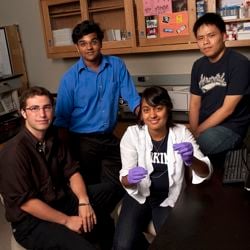A suture with stem cells for faster healing

Johns Hopkins biomedical engineering students have demonstrated a practical way to embed a patient’s own adult stem cells in the surgical thread that doctors use to repair serious orthopedic injuries such as ruptured tendons. The goal, the students said, is to enhance healing and reduce the likelihood of re-injury without changing the surgical procedure itself.
The project team — 10 undergraduates sponsored by Bioactive Surgical Inc., a Maryland medical technology company — won first place in the recent Design Day 2009 competition conducted by the university’s Department of Biomedical Engineering. In collaboration with orthopedic physicians, the students have begun testing the stem cell-bearing sutures in an animal model, paving the way for possible human trials within about five years.
The corporate sponsor, Bioactive Surgical, developed the patent-pending concept for a new way to embed stem cells in sutures during the surgical process. The company then enlisted the student team to assemble and test a prototype to demonstrate that the concept was sound. The undergraduates performed this work during the yearlong Design Team course, required in the Biomedical Engineering major.
The students believe this technology has great promise for the treatment of debilitating tendon, ligament and muscle injuries, often sports-related, that affect thousands of young and middle-aged adults annually. “Using sutures that carry stems cells to the injury site would not change the way surgeons repair the injury,” said Matt Rubashkin, the student team leader, “but we believe the stem cells will significantly speed up and improve the healing process. And because the stem cells will come from the patient, there should be no rejection problems.”
Lew Schon, a leading Baltimore foot and ankle surgeon and one of the inventors of the technology, said, “These students have demonstrated an amazing amount of initiative and leadership in all aspects of this project, including actually producing the suture and designing the ensuing mechanical, cell-based and animal trials.” Schon, who also is an assistant professor of orthopedic surgery in the Johns Hopkins School of Medicine, added that “the students exceeded all expectations. They have probably cut at least a year off of the development time of this technology, and they are definitely advancing the science in this emerging area.”
“The students did a phenomenal job,” said Richard H. Spedden, chief executive officer of Bioactive Surgical.
Along with Rubashkin, undergraduate members of the stem cell suture design team were David Attarzadeh, Raghav Badrinath, Kristie Charoen, Stephanie D’Souza, Hayley Osen, Frank Qin, Avik Som, Steven Su and Lawrence Wei.
A provisional patent has been filed covering potential improvements by the members of the Johns Hopkins student design team to the stem cell-bearing suture technology.
